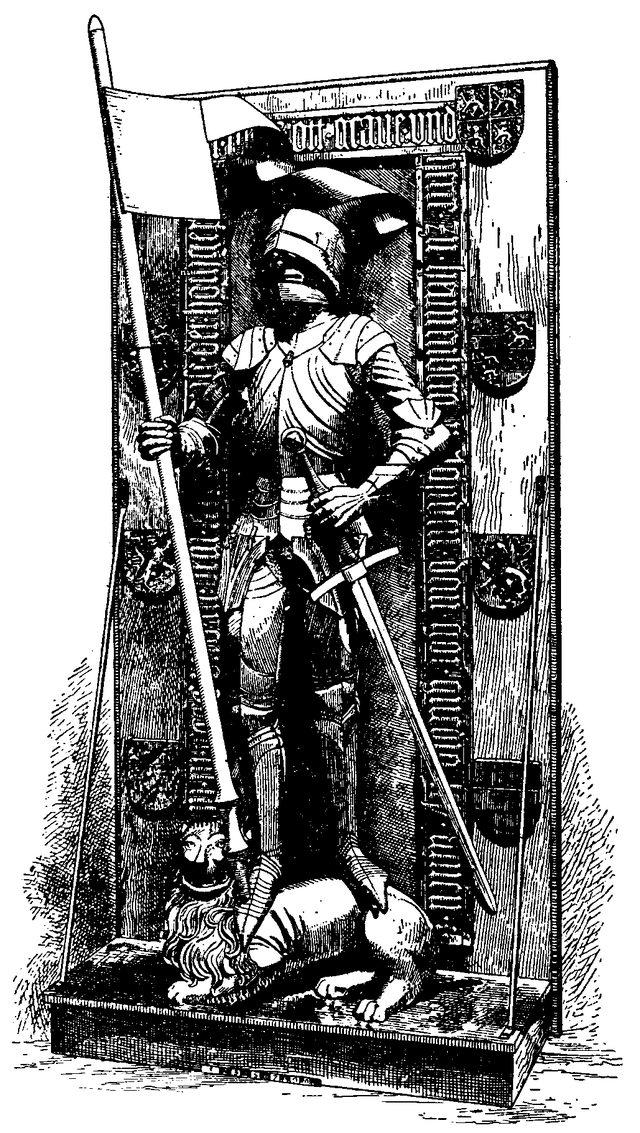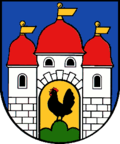Top Qs
Timeline
Chat
Perspective
House of Henneberg
German noble family From Wikipedia, the free encyclopedia
Remove ads
The House of Henneberg was a medieval German comital family (Grafen) which from the 11th century onwards held large territories in the Duchy of Franconia. Their county was raised to a princely county (Gefürstete Grafschaft) in 1310.
Upon the extinction of the line in the late 16th century, most of the territory was inherited by the Saxon House of Wettin and subsequently incorporated into the Thuringian estates of its Ernestine branch.
Remove ads
Origins
The distant origins of this family are speculative yet seem to originate in the Middle Rhine Valley, east of modern-day France. Charibert, a nobleman in Neustria is the earliest recorded ancestor of the family, dating before 636. Five generations pass between Charibert and the next descendant of note, Robert III of Worms. Both the Capetian dynasty and the Popponids (Elder House of Babenberg) are direct male lineal descendants of Count Robert I and therefore referred to as Robertians. Of the Popponids, the Henneberg are most likely to descend from Poppo, Duke of Thuringia.
The designation Babenberger, from the castle of Bamberg (Babenberch), was established in the 12th century by the chronicler Otto of Freising, himself a member of the Babenberg family. The later Younger or Austrian House of Babenberg, which ruled what became the Duchy of Austria, claimed to come of the Elder Babenberg dynasty. However, the descent of the first margrave Leopold I of Austria († 994) from the Elder Babenberger remains uncertain.
Remove ads
County of Henneberg
Summarize
Perspective

In the 11th century, the dynasty's estates around the ancestral seat Henneberg Castle near Meiningen belonged to the German stem duchy of Franconia. They were located southwest of the Rennsteig ridge in the Thuringian Forest, then forming the border with the possessions held by the Landgraves of Thuringia in the north. In 1096 one Count Godebold II of Henneberg served as a burgrave of the Würzburg bishops, his father Poppo had been killed in battle in 1078. In 1137 he established Vessra Abbey near Hildburghausen as the family's house monastery.
The counts lost their position as the bishops were raised to "Dukes of Franconia" in the 12th century. Nevertheless, in the course of the War of the Thuringian Succession upon the death of Landgrave Henry Raspe, Count Herman I of Henneberg (1224–1290) in 1247 received the Thuringian lordship of Schmalkalden from the Wettin margrave Henry III of Meissen.
After the extinction of the Bavarian House of Andechs upon the death of Duke Otto II of Merania in 1248, the Counts of Henneberg also inherited their Franconian lordship of Coburg (then called the "new lordship", later Saxe-Coburg).
In 1274 the Henneberg estates were divided into the Schleusingen, Aschach-Römhild and Hartenberg branches. Count Berthold VII of Henneberg-Schleusingen (1272–1340) was elevated to princely status in 1310, his estates comprised the towns of Schmalkalden, Suhl and Coburg. In 1343 the Counts of Hennberg also purchased the Thuringian town of Ilmenau. The Coburg lands passed to the Saxon House of Wettin upon the marriage of Countess Catherine of Henneberg to Margrave Frederick III of Meissen in 1347.
After the Imperial Reform of 1500, the County of Henneberg formed the northernmost part of the Franconian Circle, bordering on the Upper Saxon Ernestine duchies and the lands of the Upper Rhenish prince-abbacy of Fulda in the northwest. A thorn in the side remained the enclave of Meiningen, a fief held by the Bishops of Würzburg, which was not acquired by the counts until 1542.
Remove ads
Disestablishment
Whereas the male line of the House of Babenberg became extinct in 1246, the Counts of Henneberg lived on until 1583. In 1554 William IV of Henneberg-Schleusingen had signed a treaty of inheritance with Duke John Frederick II of Saxony. However, when the last Count George Ernest of Henneberg died, both the Ernestine and the Albertine branch of the Wettin dynasty claimed his estates, that were finally divided in 1660 among the Ernestine duchies of Saxe-Weimar and Saxe-Gotha and the Albertine duke Maurice of Saxe-Zeitz. The Lordship of Schmalkalden fell to Landgrave William IV of Hesse-Kassel, according to an inheritance treaty of 1360.
After the Congress of Vienna (1815), the former Albertine parts around Schleusingen and Suhl fell to the Prussian province of Saxony. King Frederick William III of Prussia assumed the title of a Princely Count of Henneberg, which his successors in the House of Hohenzollern have borne ever since.
Counts of Henneberg
House of Henneberg
Partitions of Henneberg under Henneberg rule
| County of Henneberg (1052–1262) (Gotboldian line from 1091) |
County of Frankenstein (Popponian line) (1091–1354) | ||||||
| County of Irmelshausen then County of Lichtenberg[1] (1144–1255) | |||||||
| County of Botenlauben then County of Hildenburg (1190–1251)[2] |
Burgraviate of Wurzburg (1190–1218) | ||||||
| Sold to the Prince-Bishopric of Würzburg |
|||||||
| County of Coburg (1st creation) (1245–1312) | |||||||
County of Hartenberg (1st creation) (1262–1371) |
County of Aschach (1262–1390) |
County of Schleusingen (1262–1583) |
|||||
| Annexed to Brandenburg- Salzwedel (1312–1353) | |||||||
| Inherited by the Stein zu Nord-Ostheim family | |||||||
| County of Coburg (2nd creation) (1340-1397) | |||||||
| Renamed County of Hartenberg (2nd creation) (1390–1535)[3] |
Annexed to the House of Wettin | ||||||
| County of Römhild (1535–1549) |
County of Schwarza (1535–1577) | ||||||
| Sold to the County of Mansfeld (1549–55) Sold to the Electorate of Saxony (from 1555) |
Annexed to the County of Stolberg | ||||||
| Divided between Hesse-Kassel and Saxony | |||||||
Remove ads
Notable members of the Henneberg family

- Bertold von Henneberg-Römhild (1442 – December 21, 1504), Prince-elector and archbishop of Mainz, son of George, count of Henneberg-Römhild.
- Count Otto von Henneberg, known commonly as Otto von Botenlauben from 1206, probably born in 1177 in Henneberg, died in Reiterswiesen near Bad Kissingen before 1245, was a German minnesinger, crusader and founder of Frauenroth Abbey.
- Herman I, Count of Henneberg
- Catherine of Henneberg
- William II, Princely count of Henneberg-Schleusingen
- William III, Princely count of Henneberg-Schleusingen
- William IV, Princely count of Henneberg-Schleusingen
Remove ads
Castles
- Bertholdsburg Castle, Schleusingen
- Römhild Castle
Coat of arms
Summarize
Perspective
Coat of arms of the Henneberg

The original arms of the Counts of Henneberg was a plain eagle. It was shown on the seal of Count Poppo VI in 1185 and his sons Berthold II and Poppo VII in 1202. The latter also used another coat of arms, first appearing around 1212, displaying a shield Parted per fess, above a double-headed eagle wings displayed and expanded, below chequy in three horizontal rows. The addition of the chequy may refer to the walls of Castle Botenlauben. A later depiction of the same arms, in the Weingarten Manuscript, depicting Count Otto of Bottenloube, adds the tinctures; Parted per fess, above Or a double-headed eagle sable displayed and expanded, below chequy in gules and silver in five horizontal rows. This coat of arms continued to be used until at least 1280.[27]
A new coat of arms seems to have been introduced by Poppo VII and first appears in 1237, and depicts the more familiar arms of a Hen standing on a mountain, where the hen and the mountain (Berg) are canting arms for the name Henneberg.[27]
Coats of arms incorporating Henneberg
Remove ads
See also

References
External links
Wikiwand - on
Seamless Wikipedia browsing. On steroids.
Remove ads



























